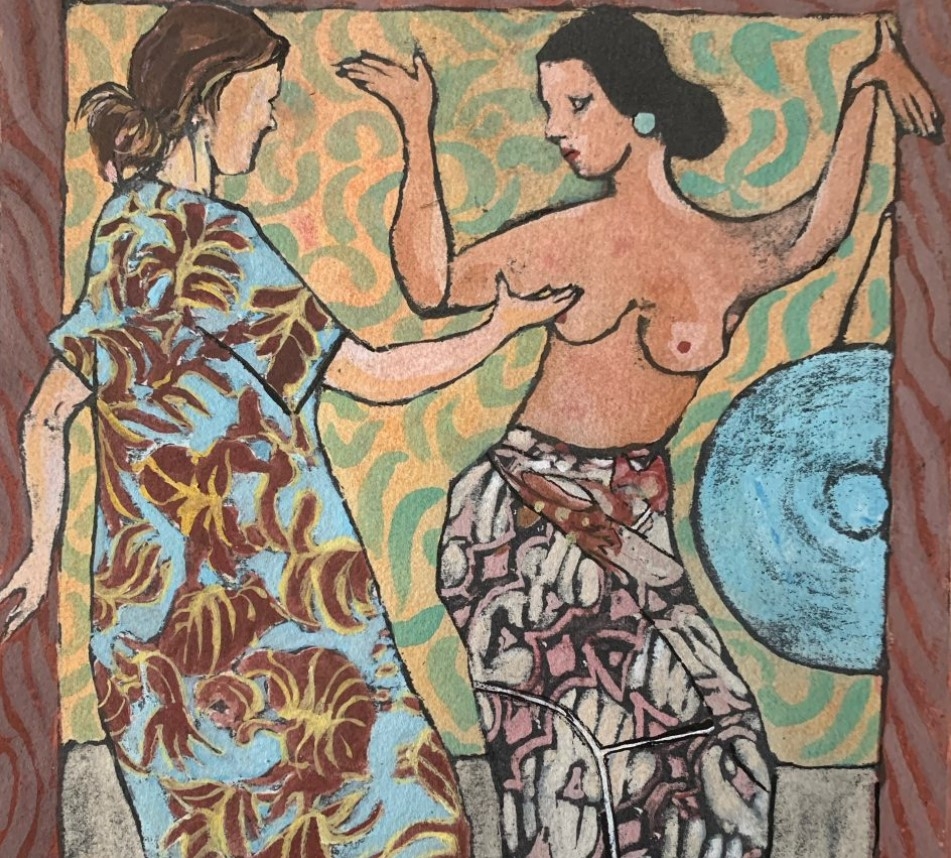KATE NYBORG, ELISABETH RASK and VIBEKE RASK
Kate Nyborg(1925-2004) was born on Java (Dutch East Indies) and grew up in Aarhus, where she trained as a painter in Gustav Bachmann’s and Åge Handest’s painting schools. Several of her earliest motifs are from the Ry region. Since then she was based in Svejbæk near Silkeborg for many years, where as a stay-at-home housewife and artist she practiced both oil and watercolor painting, sculpture and picture weaving. Kate Nyborg painted naturalistically and often figuratively, sometimes almost caricaturing. She took motifs from travels in Norway, France, England and Italy, but also from her immediate environment. Political and moral questions engaged her, and she was keenly interested in literature. Her painting style was inspired by the art trends of the time, mainly the expressive one. The paintings are therefore also a window into a rich emotional life. In her later years, Kate Nyborg lived in Kalundborg.
Elisabeth Rask (1955-) has a B.Sc. degree in history, music and art history and long-term high school teacher at GU-Aasiaat, Mulernes Legatskole and Vestfyns Gymnasium. She already worked as an advertising designer during her studies and has carried out many illustration tasks. Her earliest actual works of art date from her years in Greenland. Now she is retired and practices painting full-time as a “story painter”.
Vibeke Rask (1985-) is trained as a chemist and painting conservator. She has worked at the National Museum and Royal Copenhagen as a color specialist, but in recent years has devoted herself entirely to painting. She has just had her first exhibition at the Niels Bohr Institute.
About my mother’s pictures
By Elisabeth Rask
As far as I can remember, my mother has always painted. The first time she exhibited, I was not yet born. It was at the Artists’ Easter Exhibition in 1952. She has never had any doubts about whether she should paint. The motifs, the colors, the temptations were there and had to be impaled. Of course, the process itself could cause difficulties, but Mom has always approached the task with a great deal of cocky self-awareness. The pictures were lined up for judging in front of the whole family. There was a freshly painted smell of oil and turpentine, a smell I still associate with my mother. The house was full of mother’s things. Stones and interesting pieces of wood were dragged home from the beach and painted. Jars were given eyes, walls were ornamented and dog and children and man portrayed.
The sources of inspiration were many. There are lines to all the great isms of the turn of the century – expressionism, impressionism, symbolism, but also to abstract art. Mother has always been preoccupied with the artists’ expressions and personal destinies and has clouded the barren theoretician.
The earliest pictures are naturalistic and show her hands. But she quickly developed a personal touch, and with her personal view of the outside world, she created her own painterly universe over the years. The colors are strong and the motifs often challenging. Mother was not prone to pleasure. She had a satirical view of the self-satisfied bourgeoisie in which she herself had been brought up.
Mother’s world is diverse, at once dangerous and beautiful, but never boring. It is filled with strongly felt landscapes and populated with scorpions, gangsters, loners, fish, loving couples and medieval creatures – a seductive world if you go looking for it.”




